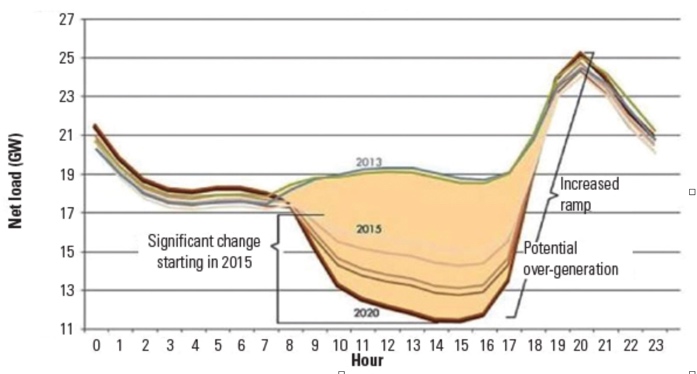The only thing that’s inevitable about the so-called ‘transition’ to wind and solar is rocketing prices and grid chaos.
The inability to deliver electricity as and when it’s needed, mean wind and solar have no commercial value – apart from the massive subsidies they attract.
Being commercially worthless is one thing, but dumping volumes of wind and solar into the grid one-minute, and watching their output completely collapse the next, comes with a staggering hidden cost.
To that end, Donn Dears unpacks the story behind California’s duck curve.
The Incredible, Amazing Duck
Power for USA
Donn Dears
29 October 2019
The Duck Curve was born in California, when the California Independent System Operator (CAISO) needed to explain how the addition of renewables affected the grid.
A quick explanation of the anatomy of the Duck Curve:
- The topmost line is the hour by hour electric load before the addition of renewables, where all of the load is supplied by baseload power plants.
- The orange body depicts the addition of renewables on the grid year by year, through 2020, where the orange area is supplied by renewables.
- The heavy line at the bottom of the curve, and the lighter lines inside the orange body for intervening years, depict the load supplied by baseline power generation after the addition of renewables.
Baseload power is typically supplied by natural gas combined cycle (NGCC) power plants, or nuclear, hydro, or coal, or a combination of them depending on which area of the country is being discussed.
Here is what the Duck is telling us.
- As more and more renewables are added to the grid the amount of electricity supplied during the daylight hours is increasingly from renewables, primarily from solar in this depiction.
- Baseload power must be quickly reduced as the sun rises to allow renewables to supply the grid.
- When the sun sets, these same baseload power plants must suddenly ramp up to meet the demand in the evening. The sudden ramping up of the power plants damages the power plants, except hydro, and various components of the grid from thermal expansions and contractions.
- Renewables are intermittent, the sun may go behind a cloud or the wind may stop blowing, so the baseload power plants must be cycled up and down to meet the variations in load. Power plants are less efficient when they are cycled in this manner which can cause an increase in air pollution, such as NOx.
It’s obvious the sun won’t shine when it rains or snows, but it’s also true wind can’t generate electricity when the wind is less than 6 mph, such as on hot summer windless afternoons. And wind turbines must be shut down when the wind blows over 55 mph, or when the temperatures go below minus 20 degree F in the winter.
- From after the sun sets until it rises in the morning, the preponderance of the electricity must come from baseload power plants, so they cannot be dismantled and eliminated. Renewables can’t eliminate baseload power plants unless electricity can be stored, which raises a large number of additional issues.
- The next picture of the Duck Curve implies what happens when renewables supply an increasing amount of electricity. All of the above problems are exacerbated, and it eventually becomes clear that utilities that own baseload power plants may find it difficult to survive without government intervention.
Storage would solve many of these problems, but even if it is technically possible to store all the electricity needed during 24 hours of the day, the amount of storage required to ensure the availability of electricity for several days when the sun doesn’t shine and wind can’t generate electricity, will cost trillions of dollars, about equal to our national debt. Storage is discussed in detail in the book Energy: The Source of Prosperity and at, Four Minutes for $150 million
The Duck tells us a great deal about renewables, and is an excellent reference whenever renewables are discussed.
Power for USA





Reblogged this on ajmarciniak.
So whats the problem?? Electricity was just a 20th century fad that never took on. Now the climate change warriors will replace it with virtual electricity generated on their computers by Sim electricity. It will all work out well in the end.
What would Also be interesting would be to superimpose energy COSTS over this graphic, as I imagine both the baseload providers but Especially the renewables providers are charging more, as it gets more difficult to provide at certain hours of the day.
Reblogged this on Climate- Science.press.